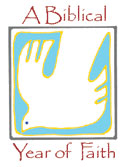Official Website of the
Catholic Diocese of Little Rock
Gospels give unique portrayals of Mary
Published: May 11, 2013
This is the eighth column in a 14-part series
By Clifford M. Yeary
Associate Director, Little Rock Scripture Study
Mary appears in all four Gospels and is present with the apostles in the book of Acts in the upper room on the day of Pentecost. How she is depicted in each of the four Gospels, however, gives us different but complementary pictures of her. To follow how she is depicted, it's interesting to start with her appearances in Mark, the earliest of the four Gospels, and then see the growth in appreciation of Mary that develops in later Gospels.
 Mark is consistent throughout his Gospel. Jesus' ministry is intent on forming faithful disciples, but all his disciples fail to understand that following him means carrying a cross, for his ministry will end on a cross. In Mark, even Jesus' family must learn that nothing will be allowed to interrupt his purpose in proclaiming the Gospel, forming disciples with his teaching and accepting his inevitable death on a cross.
Mark is consistent throughout his Gospel. Jesus' ministry is intent on forming faithful disciples, but all his disciples fail to understand that following him means carrying a cross, for his ministry will end on a cross. In Mark, even Jesus' family must learn that nothing will be allowed to interrupt his purpose in proclaiming the Gospel, forming disciples with his teaching and accepting his inevitable death on a cross.
Having no nativity account, Mark shows us a Mary whose Son, Jesus, is already active in his ministry, but the family of Jesus is fearful of the kind of attention he is getting. Perhaps they sense his ministry is attracting enemies. It may be in order to rescue him from himself that they claim, "he is out of his mind" (Mark 3:20-21). Jesus' family is fearful that he has gone off the deep end, so to speak.
We are not told directly that Mary concurred in their opinion, but shortly afterward in Mark, Mary and these male relatives (referred to as Jesus' brothers) come to a house where Jesus is teaching and try to get him to stop and join them outside (3:31-32). Jesus pays them no heed, claiming instead that those inside who are listening to his teaching, "are my mother and my brothers."
Matthew and Luke are the only Gospels that tell of Jesus' nativity and both tell us that Mary was a virgin and that she conceived Jesus through the power of the Holy Spirit (Matthew 1:18-23; Luke 1:26-35). But Matthew's account of the nativity tells us far less about Mary than it does about Joseph.
Luke, in fact, gives us more information about Mary than any other Gospel. Luke also knows that those who hear and keep Jesus' words are his true family (8:19-21). But, from the very beginning, Mary is an ideal disciple. She has known from the beginning that Jesus "will be great and will be called Son of the Most High" (1:31-33). But she does not know how that will unfold. At the presentation of the baby Jesus in the Temple, Mary is told by the prophet Simeon that Jesus will cause turmoil in the life of Israel and in her own life as well (Luke 2:34-35).
Indeed, turmoil over Jesus in Mary's life will emerge when he is 12 and abandons both Mary and Joseph on their journey home from Jerusalem in order to engage the religious teachers in the Temple. While Mary does not understand why Jesus says and does some of the things he does, she takes his words and deeds to heart (Luke 2:41-52).
The Gospel of John treats Mary as an iconic figure. Jesus refers to her as "woman" both at the beginning of his ministry in Cana and just before his death at Calvary. At the wedding she tells her Son, "They have no wine," and Jesus responds "Woman, how does your concern affect me? My hour has not yet come." But Mary seems to know that her concern will affect him. "Do whatever he (Jesus) tells you," Mary tells the wedding servants (John 2:3-5).
After the wedding she travels with Jesus and his disciples to Capernaum, but John gives no other mention of her until she appears with "the disciple whom he loved" at the cross. John alone records that Jesus gives Mary, whom he again calls "woman," and this unnamed disciple to each other as mother and son (19:25-27).
What are we to make of the importance of these two appearances of Mary in John? Scholars have often suggested that the juxtaposition of Mary, the "woman," at a wedding at the beginning of Jesus' ministry and her placement in a new family by Jesus at the end of his ministry, where she is again called "woman," depicts Mary as a new Eve, she is the mother of a new creation, the family of a renewed humanity in Christ.
Study Questions
- How does Luke's portrayal of Mary differ from Mark's? What do they share in common?
- What might be a reason Jesus refers to Mary as "woman" in John's Gospel?
- What teachings or deeds of Jesus do you have to most frequently ponder in your heart? (See Luke 2:8-19.)
- What role does Jesus' mother serve or model for you in your own spiritual life?
This article was originally published in Arkansas Catholic May 11, 2013. Copyright Diocese of Little Rock. All rights reserved. This article may be copied or redistributed with acknowledgement and permission of the publisher.









